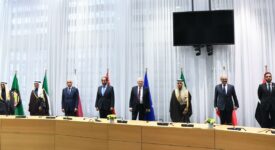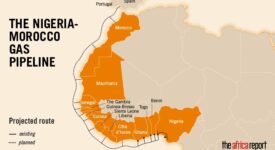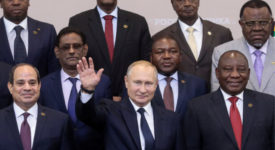The political structure established by Colonel Gaddafi was one, which lacked decision-making structures and legal foundation, but centralized oil revenue and its distribution. This strategy naturally represented a seductive prize and made zero-sum conflict after the revolution virtually inevitable. Political power in Libya is invested unaccountably in whomever controls this centralized fund of money and the means to distribute it.
Instability resulting from Libya’s revolution and civil war has never fully come under control. It has worsened with political infighting, the failures of the Government of National Accord (GNA0, and the emergence of a rival government in the east of the country. The formation of the General National Congress (GNC) in 2012 was an attempt to force the groups of the revolution into an inclusive decision-making mechanism to sit atop this inherited structure.
After the revolution, the international community originally pursued a ‘light footprint’ approach in Libya. This limited outside involvement to responding to official requests from the Libyan authorities, such as those for assistance in organizing elections. The approach effectively relegated the international community to bystanders and, as a result, Libya’s first attempts at democratic governance saw it founder and then collapse completely.
But once international actors set about pursuing a different approach, they settled on establishing what became known as the Stabilization Facility for Libya (SFL) in 2016. This marked a clear reversal of the reactive ‘light footprint’ approach. This new vehicle was to enable international institutions to identify solutions to some of Libya’s structural issues and work with partners of their own choosing. And, crucially, the GNA was to be a core partner in this new way of working for stability.
Any long-term stabilization plan cannot be successful without the involvement of the national government, but there are also other avenues for engagement. Indeed, this may even be especially important in Libya. Although there is still a long way to go in this respect, in 2013, a new municipalities law issued by the then transitional government created fresh municipalities and provided for democratic local authorities, which could use the provisions available in law such as municipal revenue generation.
A multiplicity of international actors operate in Libya, with a sometimes surprising level of cohesiveness. Nevertheless, now is the time for them to collectively agree on a high-level strategy, ensuring they have a bird’s eye view of the efforts they are all making to bring stability back to Libya. The three main components of this stabilization are: ensuring the delivery of public services; stabilizing the economy; and providing security. There has been some progress on the first component, but stabilization actors must now focus on the economy. Innovation at municipal level and the weakness and corruption of central government mean that international players should look to local authorities as partners for re-establishing public services.
‘Order from Chaos: Stabilizing Libya the Local Way’ – Policy Brief by Tarek Megerisi –European Council on Foreign Relations / ECFR.







